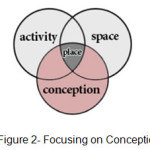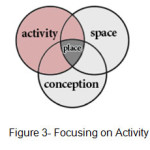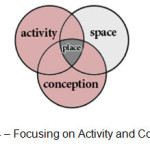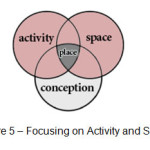Dwelling in the Workplace: A Contribution to the Phenomenological Attributes of the Workplace
Sahar Soltani1 * , Saba Naser Alavi2 and Azadeh Khaki Ghasr3
1
Department of Architecture,
Yazd University,
Yazd,
Iran
2
Department of Architecture and Urbanism,
Tehran University,
Kish,
Iran
3
Department of Architecture,
Yazd University,
Yazd,
Iran
Corresponding author Email: s.soltani.ma@gmail.com
DOI: http://dx.doi.org/10.12944/CWE.10.Special-Issue1.98
Physical and spatial attributes are some factors influencing various aspects of content and form, thus they contribute to change people’s behavior and social patterns. Social relations and behaviors seem to require a suitable context. One of the places where people experience their everyday life and spend a substantial amount time is the workplace. In the past, due to smaller facilities and flow of work in the life, much attention was considered understanding the work culture and its customs. In general, we can say that the spirit of place and a sense of culture in current work spaces are ignored. This review study, using qualitative research method, is based on the library studies and trying to use a descriptive study to define workspace as a place. Consequently, the aim of this study is to search the potential qualities of "being", and finally achieve the criteria for the definition of dwelling in these spaces.
Copy the following to cite this article:
Soltani S, Alavi S. N, Ghasr A. K. Dwelling in the Workplace: A Contribution to the Phenomenological Attributes of the Workplace. Special Issue of Curr World Environ 2015;10(Special Issue May 2015). DOI:http://dx.doi.org/10.12944/CWE.10.Special-Issue1.98
Copy the following to cite this URL:
Soltani S, Alavi S. N, Ghasr A. K. Dwelling in the Workplace: A Contribution to the Phenomenological Attributes of the Workplace. Special Issue of Curr World Environ 2015;10(Special Issue May 2015). Available from: http://www.cwejournal.org/?p=10879
Download article (pdf)
Citation Manager
Publish History
Select type of program for download
| Endnote EndNote format (Mac & Win) | |
| Reference Manager Ris format (Win only) | |
| Procite Ris format (Win only) | |
| Medlars Format | |
| RefWorks Format RefWorks format (Mac & Win) | |
| BibTex Format BibTex format (Mac & Win) |
Article Publishing History
| Received: | 2015-03-21 |
|---|---|
| Accepted: | 2015-03-25 |
Introduction
“Buildings make the earth, the landscape of dwelling, closer to the human”. This expression of Heidegger puts settlements and homes on an equal level, and take the same importance for all buildings, with the divers large degree.1 People daily experience various spaces. From this point of view, all these spaces must provide the conditions that can match with qualities of human presence. Workplace, due to its close relationship with the human future and their daily life, is one of the most important spaces among them. All workplaces, organizations, offices, factories and manufacturing centers seek to increase the efficiency of their employees, so creating a healthy environment is the first and most essential step forward to this aim. Besides, physical and mental health of people has an effect on other aspects of individual, family and community life.2,3 Human life is so associated with work that future of the work can be considered same as the human future.4 Various views on this issue have been raised among which we can mention the perspective of industrial development and human development. In the industrial development, we will see a huge development in the field of technology and science in which the goals would be quantitative and objective, and people hide in corporate responsibilities and a sense of alienation. In contrast, human development, the future is not limited solely to the hasty automated advancement of technology, and the emphasis is on human capacity and giving him freedom and human dignity are considered; In conjunction with human development, knowledge and science improve and expand.5 The considerable question is the importance of the originality of human presence in an environment. When “being” happens through the sense of belonging to a place, and the building also is meant by the human presence, it becomes possible to strengthen the sense of individual identity.1 Therefore, looking at the meaning of these concepts, we assess the quality of the work environment through the perspective of phenomenology.
Work, with communication, organizational culture and cultural transmissions, is one of the salient features of a human. Some anthropologists believe that work is the most important humans’ attribute, and human evolution and society are provided by the power of his thought and arm. However, it has been changed during various historical periods.6
Materials and Methods
Model of Place: David Canter, the professor of psychology at the University of Liverpool, has been working in the field of psychological research plan in the past two decades. His approach is a systematic reflection on the analysis of human behavior. Canter suggested a novel model of place which shows the degree of being meaningful for a place rating within three elements: activities, spaces and conceptions.7 Later place models were generally introduced based on this model. Christian Norberg-Schulz and Rappaport, including those who had paid special attention to the perceptional quality of place.1,8
Following, a brief definition of the place and dwelling is explored in order to learn more about these concepts, then through the theoretical framework of these issues the ability of handling that in the workplace is parsed.
Place: A place is an area in which we exist and undergoing significant and meaningful events of our lives; consequently, the concept of dwelling is possible with the human presence in space and create a meaningful connection with it.8,9 Being human means to live in a world that is full of meaning, to have and know the place and gain a comprehensive perception of his place. Luckmann knows the place as a complex combination of nature and culture which developed or is developing, and connected to other places by interactions between people and experiences.10 Place, as a space with character, has also a substantive relation to identity. From the perspective of place phenomenology, the concepts of spirit and sense of place only derive from this identity and character which impress in various ways of dwelling.8
![Figure 1- Place model of Canter [7]](http://www.cwejournal.org/wp-content/uploads/2015/05/Vol10_Spe_Dwel_SAHA_Fig1-150x150.jpg) |
Figure 1: Place model of Canter [7] Click here to View figure |
Dwelling: As Schultz suggested, architecture associated with dwelling, so goes into the being placed. Dwelling represents a meaningful link between humans and assumed environment. This connection is caused by trying to find an identity, and have a sense of belonging to a place. Establishing intimacy with such setting is natural that reflects the authentication of identity.
Concepts that can be inferred from the dwelling from the perspective of Schultz categorized as follows:
Collective: Meeting with others to exchange products, ideas and feelings that examine life as the various facilities.
Public: To agree with other people who accept a set of common values. Since public buildings include set of beliefs and values should be as a clear picture in the mind of all people and are derived from the culture.
Private: Finding entities through the selection of one’s own small world. Dwelling provides isolation required for the formation and training of the person's identity. Indeed, activities that should be kept away from the interference of others can be called private dwelling.
Expression of these three areas can be examined in four ways of dwelling: village, urban space, institution, home.
Settlement: settlement is a natural point of geography shaped base on that. When a settlement is chosen, another way of dwelling which related to the primitive correlation between humans and revealing human events arise.
Urban space: urban space is the area that meetings and gathering happen. One of the differences between urban areas and villages is the density, which notes not only increasing in number of people but also obtaining an identity. By utilizing the word "association" with the radical notion that is “the community” and “coming together”, we can call this way of living “collective”.
Institution: Agreement in this field represents the common interests and values; therefore, the way it serves residents, with the word "collective", based on what is invested in the community and the general public, can be called private dwelling.
Home: Home is the basement of our identity as individuals and members of a community and a place for settlement. Home has an irreplaceable conception.8
Results and Discussion
Place Attributes of Workplace
As discussed in the explanation of the canter’s model of place, a place can be identified by impressing the place dimensions in conceptions, spaces and activities.7 Therefore, within reviewing and providing guidance for the development of each of these areas, a better quality of place features can be achieved. In this section, to assess the capabilities some integral part of each of the above areas of the workplace will be reviewed
Conceptions
Artificial separation of the life and work creates an intolerable gap in their lives. According to Alexander, if people work 8 hours per day and 8 hours at home, there's no reason that your workplace is less than their home. Why people usually don’t choose the word “living”, concerning with every moment of our waking time and spending time with family at home, for working time. People think that when they work, they are less alive than when they are at home. Alexander explained this difference by choosing the word “living” for the places and moments of our lives on which we don’t work.11,12 Everyone uses the word “living” accepts the regular cultural concept of that which tells nobody really lives in their workplace, and that when people work they are not alive. In today’s world, almost all cities have separate areas for working zone and living. While in traditional societies not only work zones were small but also the level of demand for families was lower. This separation reinforces the idea that work is a tool and only the family has the living soul.11
 |
Figure 2: Focusing on Conception Click here to View figure |
- Office spaces, according to the principles of human work:
As Alexander pointed out, if people are looked as the gears of a machine, they don’t enjoy of their jobs. A person enjoys his job when he or she involves with all work affairs and be responsible for them. Work is a process of life which has its own natural benefits. Any other type of work inconsistent with this idea and manages the work within industrial affairs, is in contrast with humanity. Managing the Bureau in a way that make it meaningless, boring, and monotonous for the workers, is not lower than crime. In such condition, commodities will be more valuable than individuals; as a person deems his or her work worthy sufficient, and also given enough opportunity, he or she can distinct the difference between machine and human. The nature of the development of civilization should be investigated in human identity and personality. The personality is shaped by the work someone does.12
Activities
Providing a public dining saloon
Public dining saloons play a vital role in almost all human societies. The importance of eating together is evident in all human societies: Holy orders, weddings, birthdays, mourning ceremonies, parties, etc. Thomas Merton explains that in this way: recently, we have fallen away from the fact that even in the most ordinary daily activities a profound spiritual concept is invested by their nature. The people around the table are the center and concept of the family. It is where the atmosphere is friendly and appreciation is extended by the exchange of ideas and opinions and results in happiness. It is indeed a common way to connect people to each other and to strengthen their feelings as members of a group.11
 |
Figure 3: Focusing on Activity Click here to View figure |
Conceptions and Activities
Establishing small working groups:
Indeed, both working in a big and busy place with a lot of workers and also working alone puts pressure on individuals. Because compared to the populated places where there is no chance for survival of an intimate sociable combination, better coordination is achievable through small groups, and also when the number of individuals is less than a certain amount, the possibility of forming a social group is wasted. Studies done on the working groups in various departments have shown that in large organizations the individual feels that they do not play an important role and it is bothersome when they feel being observed constantly by others. When more than six people are in one place, they must not all share the same space to work, but the space should be divided into some sections and people work in small groups; and when the number of people is high, people cannot communicate in a group and almost no one is able to work alone.13
 |
Figure 4: Focusing on Activity and Conception Click here to View figure |
Spaces and Activities
The size of social organization and feeling alienation
James Rovers believes that: there is a relationship between the number of inhabitants of a behavioral surrounding and the frequency, severity, onset and termination of the pressures exerted on them there. Roger Bechtel has a specific definition of human scale. His definition is quite different from the characteristics of the human polls (Le Corbusier 1951).13,14 In Barker’s human scale conception, population correlates with the number of behavioral places available for people. And this definition is important because in many cases, these feelings of alienation can be attributed to the environment.15 This is while the sense of alienation is further linked to the overcrowding of behavioral places. This means that the policies and achievements of social institutions depend on the capabilities of the physical configuration of the environment.The main assumption of the theory of humanizing the environment is that when in a behavioral place, the number of participants is less than the required number, the people show more contribution in activities for the survival of that place. And they are challenged more and there are more responsibilities for them so that they feel less alienated.11,12,13
 |
Figure 5: Focusing on Activity and Space Click here to View figure |
- Creating flexible Office Space
We should create an environment that specifically recognizes those who are working and at the same time is able to create unlimited number of different arrangements and composition. For instant, older homes whose function has been changed have more flexibility compared to open office space or landscape of offices, because the large number of small and big rooms, that are connected to each other in many different ways, have the capability to meet the needs for different activities. Before making working space, we should know about the working group that is supposed to work in that place, which is often not known at the time of making it. In that case some kind of spaces can be designed that can systematically and gradually transform into a kind of homelike atmosphere. It means that we should predict a variety of places all around the office comparing to a variety of different sizes and different types of spaces with regard to the rule of preserving the flexibility.11,12
- Creating Balance Between Communication and Privacy
In a professional project, fully private offices have a devastating impact on the process of people's communication and have a major role in shaping negative impression of the whole office. Also, there will be times when you will need to be alone and almost in all jobs, avoiding the inconvenience and unplanned disruptions is needed. Consequently, having separate and closed private offices must be avoided. The office must be available for other working groups and the outer environment, whether it accommodates three people or just one person and it is better to be designed semi-open so that it will always have communicational property and privacy at the same time.11,12,13
Conclusion: One of the concerns in relation to this subject was indifference to the value and quality of architectural spaces in the field of workplaces. The importance of the role of these places in mental health, happiness and vitality of employees, and the importance of the dignity of people, highlight the important role of architecture in the creation of a suitable base which can provide required quantitative and qualitative capabilities. Also, with the long-term presence of individuals in workplace and engagement of a significant population of the society in these places, it would be more important to focus on cultural issues and social activities within this framework.
Different communities consider "work" in different ways. When approaches are varied, the way each one deals with these spaces would be different. In Iran, there are two kinds of perception of workplace: the past culture and the culture of today. In the past, there were no boundaries like this; and now when work and daily life are separated, the meaning of life and true residence does not happen in this space. Design of workplace is not the only expression of functional diagram between its various activities, and it should be defined as a Place. Therefore, with making dwelling conditions of work close to the living conditions of home - with regard to the differences- dwelling values of man in these spaces will be obtained.
References
- Norberg-Schulz, C.Architecture: presence, language and place. (Skira Editore, 2000).
- Needleman, Ruth, Quality of Worklife from a Labor Perspective: A Review Essay on Inside the Circle, Labor Research Review. 1( 7), Article 2 (1985).
- Oseland, N., Burton, AQuantifying the impact of environmental condition on worker performance for inputting to a business case to justify enhanced workplace design features. Journal of Building Survey. (2012).
- Alvani, Mehdi, Work Future From two perspectives: Industrial Development- Human Development, Journal of Name-e-Farhang. 26 (1998). (In Persian)
- Robertson, J., Future work : jobs, self-employment and leisure after the industrial age. (New York: Universe Books,1985).
- Tavasoli, GH., Sociology of work and job, The organization of study and development, humanities, (university's books (SAMT), 2002). (In Persian)
- Canter, David, The Psychology of Place, (Architectural Press, 1977).
- Norberg-Schulz, Christian, The concept of dwelling: on the way to figurative architecture, (Architectural documents, 1984)
- Luckmann, T., Phenomenology and sociology, (Penguin Books, 1987).
- Alexander, Christopher, A Pattern Language: Towns, Buildings, Construction, (Oxford University Press, 1977).
- Salingaros, n., A new type of work environment: Cristopher Alexander's ideas on office furniture and interiors. Retrieved 23 June 2011 from:
- Lang, Jon, Creating Architectural Theory: The Role of the Behavioral Sciences in Environmental Design, (Van Nostrand Reinhold, 1987).
- Bechtel, R. B., Enclosing behavior, (Dowden, Hutchinson & Ross, 1977).
- Moleski, W. H., & Lang, J. T., Organizational Needs and Human Values in Office Planning. Environment and Behavior, 14(3), 319-332 (1982).
- Bluyssen, P. M., Aries, M., & van Dommelen, P., Comfort of workers in office buildings: The European HOPE Building and Environment, 46(1), 280-288 (2011).






